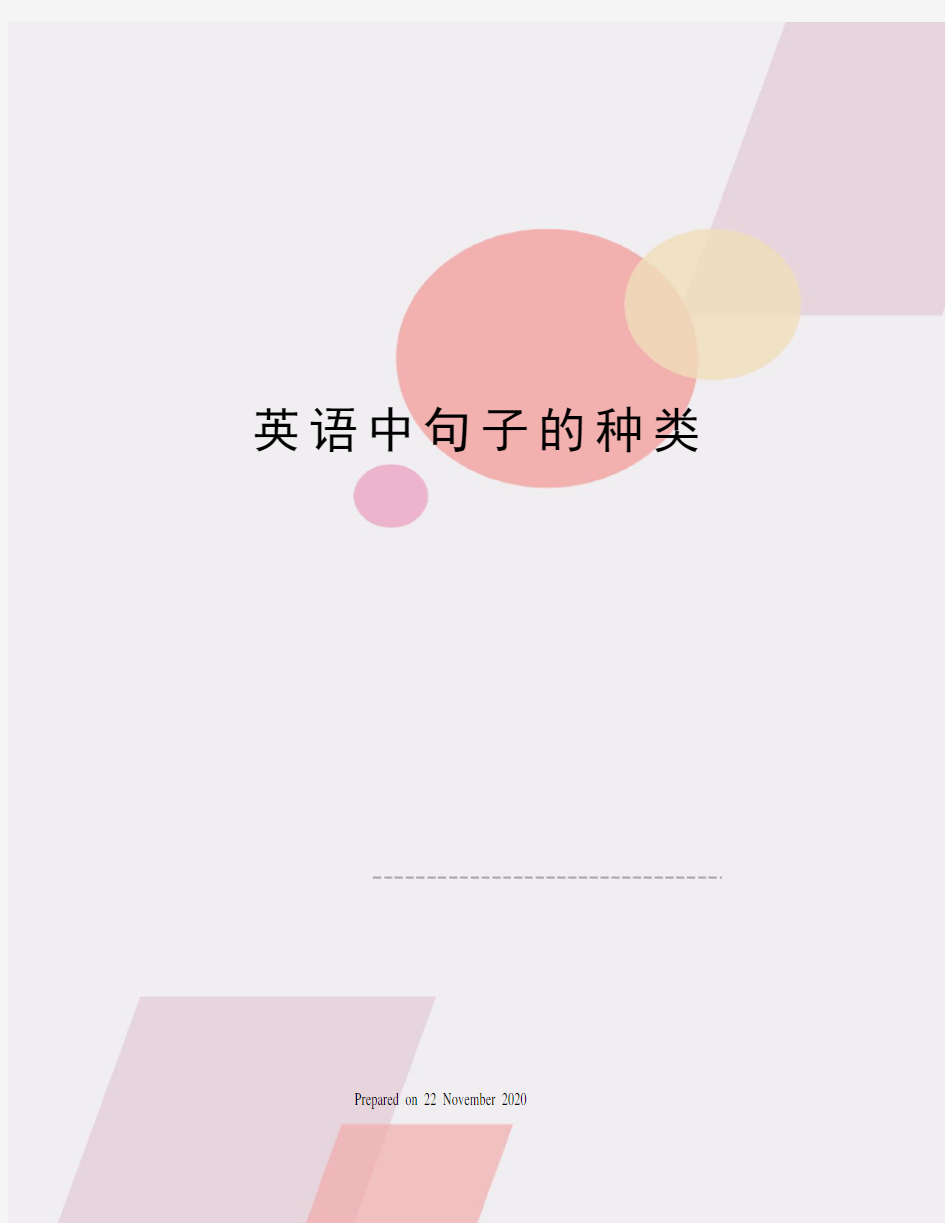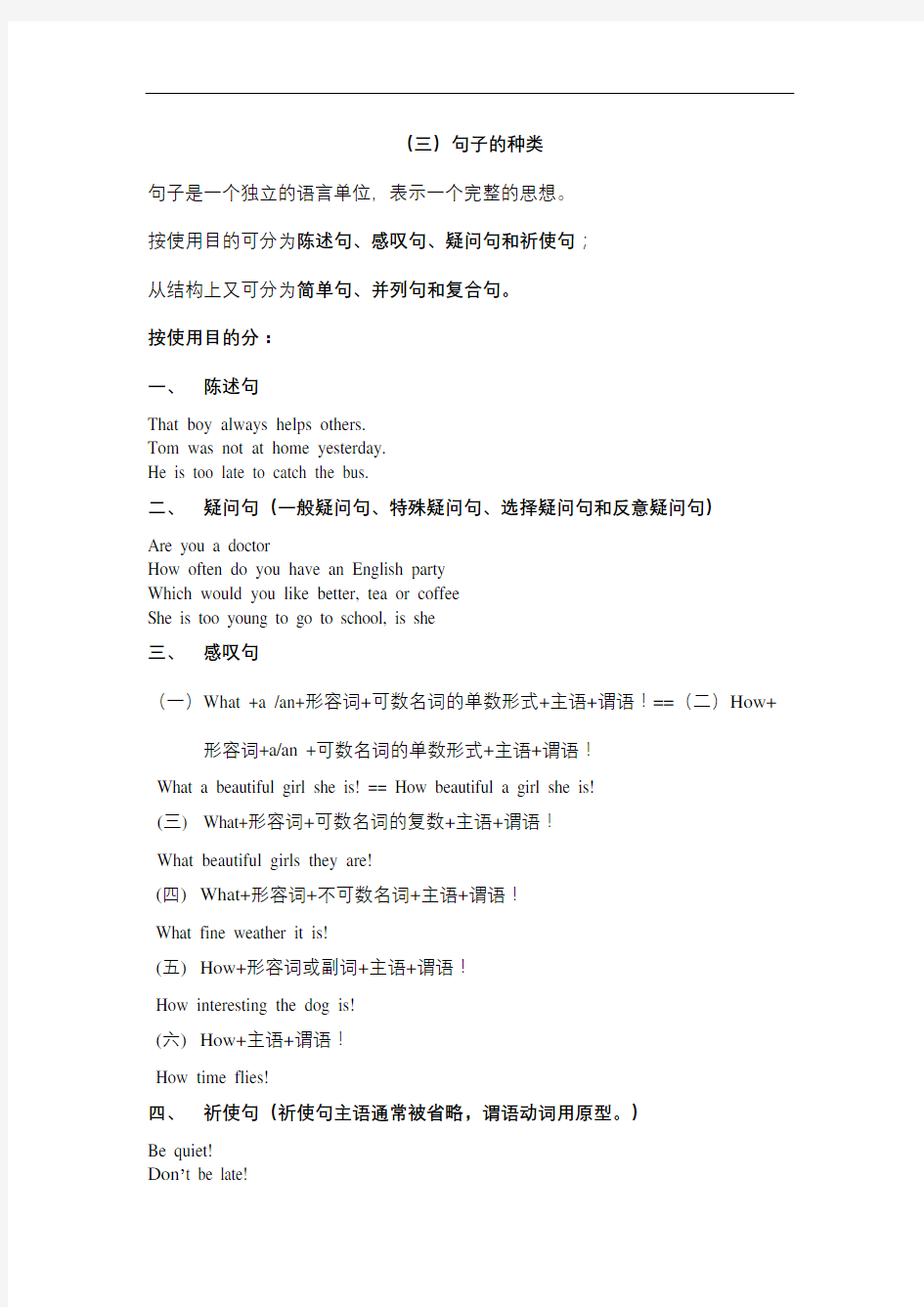

英语中句子的种类 Prepared on 22 November 2020
(三)句子的种类
句子是一个独立的语言单位,表示一个完整的思想。
按使用目的可分为陈述句、感叹句、疑问句和祈使句;
从结构上又可分为简单句、并列句和复合句。
按使用目的分:
一、陈述句
That boy always helps others.
Tom was not at home yesterday.
He is too late to catch the bus.
二、疑问句(一般疑问句、特殊疑问句、选择疑问句和反意疑问句)
Are you a doctor
How often do you have an English party
Which would you like better, tea or coffee
She is too young to go to school, is she
三、感叹句
(一)What +a /an+形容词+可数名词的单数形式+主语+谓语!==(二)How+形容词+a/an +可数名词的单数形式+主语+谓语!
What a beautiful girl she is! == How beautiful a girl she is!
(三) What+形容词+可数名词的复数+主语+谓语!
What beautiful girls they are!
(四)What+形容词+不可数名词+主语+谓语!
What fine weather it is!
(五)How+形容词或副词+主语+谓语!
How interesting the dog is!
(六)How+主语+谓语!
How time flies!
四、祈使句(祈使句主语通常被省略,谓语动词用原型。)
Be quiet!
Don’t be late!
从结构上分:
一、简单句(句子只包含一个主谓结构。)如,五种基本句型列式如下:
基本句型一:主+系+表
基本句型二:主+谓
基本句型三:主+谓+宾
基本句型四:主+谓+间宾+直宾
基本句型五主+谓+宾+宾补.
二、并列句(句子包含两个或多个主谓结构,通常有并列连词连结。)
由并列连词把两个或两个以上的简单句连在一起的句子叫并列句。不同的并列连词表示并列分句之间的不同关系。根据并列分句之间的关系不同,并列句可以分为以下几种: 1.表示联合关系的并列句这类并列句常用并列连词and (和),not only ... but also... (不但……而且……)等来连接,这时分句之间是顺承关系或并列关系。and一般不译出来。
1. We bought her a birthday present,_____ she liked it very much.
A. so
B. or
C. and
D. but
2. — Didn’t you give roses to your father on Father’s Day
— Oh, not only my father,_____ my grandpa got red roses.
A. or
B. and
C. but
D. until
2.表示转折关系的并列句这类并列句常用but (但是;可是),yet(可是;然而),while (而)等来连接,后面分句与前面分句之间有意义上的转折关系。
1. — Would you like to go to the concert with me
— I’d love to,_____ I can’t. I have a lot of homework to do.
A. or
B. but
C. so
D. and
2. The doctors tried their best to save the patient’s life,_____ failed
A. or
B. so
C. but
D. because
3.表示选择关系的并列句这类并列句常用并列连词or(或者),either … or …(要么……,要么……)等连接。
1. _____ Lily _____ Lucy may go with you because one of them must stay at home.
A. Not only; but also
B. Neither; nor
C. Both; and
D. Either; or
2. None of the shoes in the shops are the right size. They are _____ too big _____ too small.
A. both; and
B. neither; nor
C. either; or
D. not only; but also
3. “Are you going to eat here ____ take it away” asked the waiter..
A. and
B. so
C. or
D. but。
4.表示因果关系的并列句这类并列句常用并列连词so(因此;所以),for (因为)等连接,后面分句与前面分句之间有因果关系。
1. Mother was ill,_____ Father cooked for us instead.
A. but
B. or
C. so
D. and
2. There is a lot of traffic in this city,_____ look both ways before crossing the
street
A. so
B. and
C. but
D. for
特殊的并列句
1.祈使句+and+一般将来时的句子这个句型表示“如果做到了祈使句表示的
事情,就会有后面句子表示的结果”。
2.例如: Study hard,_____ you are sure to have a good result in the exam.
A. or
B. and
C. for
D. but
3. 2. 祈使句 + or + 一般将来时的句子这个句型表示“如果做不到祈使句表
示的事情,就会有后面句子表示的结果”
4.例如: 1. Be quick,_____ we’ll be late for class.
A. or
B. so
C. and
D. but
2. Come a little earlier next time,_____ you’ll miss the best part of the TV
play.
A. and
B. but
C. or
D. till
三、复合句
复合句(Complex Sentence)由一个主句(Principal Clause)和一个或一个以上的从句(Subordinate Clause)构成。主句是全句的主体,通常可以独立存在;从句则是一个句子成分,不能独立存在。从句不能单独成句,但它也有主语部分和谓语部分,就像一个句子一样。所不同在于,从句须由一个关联词引导。我们至今学过的从句有:定语从句,名词性从句(主语从句、宾语从句、表语从句、同位语从句),和状语从句。
1. 定语从句 He is the man who wants to see you.
2. 同位语从句 She told us her hope that she would become a pianist.
注意:定语和同位语从句的区别。
3. 表语从句 This is what we should do
4. 宾语从句(注意it做形式宾语)
Everybody knows that money doesn't grow on trees
We think it wrong that he told a lie to everyone. (it做形式宾语)
5.主语从句(注意it做形式主语)
What caused the accident remains unknown
It is certain that he will win the match(it做形式主语)
6.状语从句
MyfriendsdislikemebecauseI’mhandsomeandsuccessfu l.